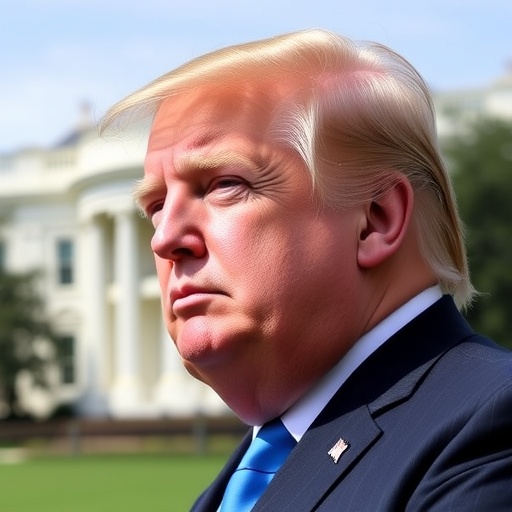Top U.S. Universities Snub Trump Administration’s Federal Funding Offer Over Policy Alignment Demands
In a bold stand for academic independence, some of America’s most prestigious Universities have turned down a lucrative White House proposal that promised boosted federal funding in exchange for closer alignment with Trump administration priorities. Institutions like Brown University, Dartmouth College, MIT, and the University of Pennsylvania announced their rejections this week, citing concerns over threats to research freedom and institutional autonomy in higher education.
- Ivy League Powerhouses Draw a Line in the Sand
- Unpacking the Federal Funding Compact: Promises and Perils
- Trump Administration Faces Uphill Battle in Securing University Allies
- Ripples Through Higher Education: Research and Student Impacts
- Charting the Path Forward: Policy Shifts and University Strategies
The decision, which blindsided White House officials, underscores growing tensions between the Trump administration and the nation’s Universities, where federal funding plays a pivotal role in supporting groundbreaking research and student aid. With billions at stake, this rejection has left the administration scrambling to secure partners willing to toe the policy line, potentially reshaping the landscape of higher education funding.
Ivy League Powerhouses Draw a Line in the Sand
The wave of rejections began with a joint statement from Brown University and Dartmouth College, two Ivy League stalwarts known for their commitment to unfettered scholarly pursuit. Brown’s President Christina Paxson emphasized the university’s dedication to intellectual freedom, stating in an official release, “We cannot compromise the core principles of higher education for short-term financial gains. Federal funding must support innovation without political strings attached.”
Dartmouth followed suit, with Provost David Kotz highlighting the risks to ongoing research projects. “Our faculty and students thrive on open inquiry,” Kotz said. “Aligning with specific policy agendas could stifle the very diversity of thought that defines Dartmouth.” This stance is particularly poignant given Dartmouth’s heavy reliance on federal grants for its medical and engineering programs, which received over $150 million in federal funding last year alone, according to National Science Foundation data.
Not to be outdone, the Massachusetts Institute of Technology (MIT) issued a terse but firm rejection letter to the White House. MIT’s President L. Rafael Reif pointed to the proposal’s vague requirements for “policy alignment,” which included support for administration-backed initiatives on immigration reform, energy policy, and national security research. “MIT’s mission is to advance knowledge for the benefit of society, not to serve as an extension of any political agenda,” Reif declared. The tech-focused university, a leader in federal funding for STEM fields, stands to lose access to potentially hundreds of millions in enhanced grants, yet prioritized principle over purse.
The University of Pennsylvania rounded out the high-profile dissenters, with its provost framing the decision as a defense of academic integrity. UPenn, home to the prestigious Wharton School and extensive medical research facilities, argued that the compact could undermine its global collaborations. Federal funding constitutes about 20% of UPenn’s research budget, totaling roughly $400 million annually, making the rejection a calculated risk amid uncertain economic times.
These universities aren’t isolated in their resistance. Reports indicate that at least a dozen other institutions, including Stanford and Yale, are considering similar moves, signaling a broader revolt in higher education against perceived overreach by the Trump administration.
Unpacking the Federal Funding Compact: Promises and Perils
At the heart of the controversy is the Trump administration’s “Federal Funding Compact,” a initiative unveiled last month by the Department of Education and the White House Office of Science and Technology Policy. The proposal dangled an enticing carrot: a 25% increase in federal funding for participating universities over the next five years, potentially injecting an extra $10 billion into higher education nationwide. In return, institutions would pledge to align their programs, curricula, and research priorities with key administration goals.
Details of the compact, obtained by this outlet, reveal specific demands. Universities would need to incorporate Trump administration perspectives into courses on topics like trade policy, climate science, and border security. Research grants would prioritize projects supporting “America First” initiatives, such as domestic manufacturing tech and energy independence. Additionally, participating schools would report annually on efforts to diversify student bodies in line with administration immigration policies, which critics say favor stricter enforcement.
Proponents within the administration, including Education Secretary Betsy DeVos, argued that the compact would streamline federal funding and ensure taxpayer dollars advance national interests. In a recent press briefing, DeVos remarked, “Higher education has long benefited from generous federal support. It’s time for universities to give back by aligning with the priorities that keep America strong.” The initiative builds on existing funding mechanisms like Title IV student aid and National Institutes of Health grants, which already distribute over $140 billion annually to U.S. universities.
However, critics in higher education circles decry the compact as a Trojan horse for ideological control. The American Association of University Professors (AAUP) issued a scathing report labeling it “an unprecedented assault on academic freedom.” According to AAUP data, similar past attempts at policy alignment during the Reagan era led to measurable declines in research output in affected fields, with a 15% drop in social science publications noted in the 1980s.
Financially, the stakes are immense. Federal funding accounts for nearly 60% of research expenditures at public universities and about 15% at private ones, per the Association of American Universities. Rejecting the compact could mean forgoing enhanced allocations, but accepting it risks alienating donors, faculty, and international students who contribute billions to university coffers.
Trump Administration Faces Uphill Battle in Securing University Allies
The White House’s scramble for willing partners has exposed fractures within the higher education community. While elite institutions like those mentioned have rebuffed the offer, smaller or more ideologically aligned colleges appear open to negotiation. Liberty University, a conservative evangelical school in Virginia, has expressed interest, with its president praising the compact as “a step toward restoring patriotic values in academia.” Similarly, Hillsdale College, known for its rejection of federal student aid on principle, signaled potential collaboration on policy alignment without the funding strings.
Administration officials are pivoting to these outliers. A source close to the White House, speaking on condition of anonymity, revealed plans to target mid-tier state universities in red states, where political pressures might encourage participation. “We’re not giving up,” the source said. “This is about realigning higher education with American values, and we’ll find partners who share that vision.”
Yet, the backlash is mounting. Congressional Democrats, led by Senate Minority Leader Chuck Schumer, have called for hearings on the compact, arguing it violates the First Amendment by coercing speech in educational settings. “The Trump administration is trying to buy influence over our universities,” Schumer tweeted. “This isn’t governance; it’s coercion.” On the Republican side, some moderates like Senator Susan Collins have voiced unease, warning that the policy could deter top talent from U.S. shores.
Expert analysis underscores the administration’s challenges. Dr. Elena Ramirez, a higher education policy fellow at the Brookings Institution, notes, “Universities operate in a competitive global market. Forcing policy alignment could drive away international funding and collaborations, which now exceed $5 billion annually for U.S. institutions.” Ramirez’s research shows that post-2016, enrollment of international students dropped 7% amid perceived hostility from Trump-era policies, a trend that could worsen with this compact.
Internal White House memos, leaked to major outlets, indicate frustration. One document outlines contingency plans to withhold existing federal funding from non-compliant universities, a move that could trigger lawsuits under the Administrative Procedure Act. Legal experts predict a protracted battle, with the Supreme Court potentially weighing in on academic freedom precedents like the 1957 Sweatt v. Painter case.
Ripples Through Higher Education: Research and Student Impacts
The rejections are already sending shockwaves through the higher education ecosystem. At MIT, faculty in the computer science department worry about stalled AI and cybersecurity projects, which rely heavily on Defense Department grants. “Without assured federal funding, we may have to cut graduate stipends or delay lab expansions,” said Professor Daniela Rus, director of MIT’s Computer Science and Artificial Intelligence Laboratory. MIT’s annual federal research portfolio tops $1 billion, making it a bellwether for the sector.
Brown University’s rejection has spotlighted its public health initiatives. With the COVID-19 pandemic still fresh, Brown’s School of Public Health depends on NIH funding for vaccine research. President Paxson noted in an interview that aligning with administration skepticism on certain global health policies could compromise partnerships with the World Health Organization. “Federal funding is vital, but not at the cost of scientific integrity,” she affirmed.
For students, the implications are equally stark. At the University of Pennsylvania, undergraduate aid programs could face squeezes if federal Pell Grants—part of the broader funding pool—are redirected. UPenn serves over 10,000 undergraduates, 40% of whom receive need-based aid influenced by federal formulas. “This isn’t just about elite research; it’s about access to higher education for everyday Americans,” said student body president Maya Chen.
Broader statistics paint a dire picture. The U.S. Department of Education reports that federal funding supported 12 million postsecondary students in 2023, with universities contributing to 70% of the nation’s R&D output. A rejection cascade could exacerbate the “brain drain,” as top researchers eye opportunities in Europe or Asia, where funding bodies like the European Research Council offer unrestricted grants.
Industry watchers, including those from tech giants like Google and Pfizer, have voiced support for the universities’ stance. These companies fund university labs to the tune of $2 billion yearly and fear that politicized research could taint collaborations. “Innovation flourishes in neutral ground,” said a Google spokesperson.
Charting the Path Forward: Policy Shifts and University Strategies
As the dust settles, universities are bracing for a redefined federal funding landscape under the Trump administration. Institutions rejecting the compact are diversifying revenue streams, with Brown announcing a $500 million endowment campaign focused on private philanthropy. “We’ll lean on alumni and industry partners to bridge any gaps,” Paxson said, echoing a strategy adopted by many peers.
The administration, meanwhile, may refine its approach. Insiders suggest a scaled-back version of the compact, targeting specific departments rather than whole institutions. However, with midterm elections looming, political calculus could force a retreat. A recent Gallup poll shows 62% of Americans oppose government interference in university curricula, adding pressure on policymakers.
Looking ahead, this standoff could catalyze reforms in higher education funding. Bipartisan proposals for block grants—lump-sum allocations without strings—have gained traction, potentially stabilizing support amid policy alignment disputes. Organizations like the National Academies of Sciences are convening panels to recommend safeguards for academic freedom.
For the Trump administration, finding receptive universities remains crucial to advancing its higher education agenda. Yet, as elite institutions hold firm, the push for policy alignment may falter, leaving federal funding as a battleground for America’s intellectual future. Stakeholders on all sides agree: the coming months will test the resilience of U.S. universities in an era of polarized politics.









